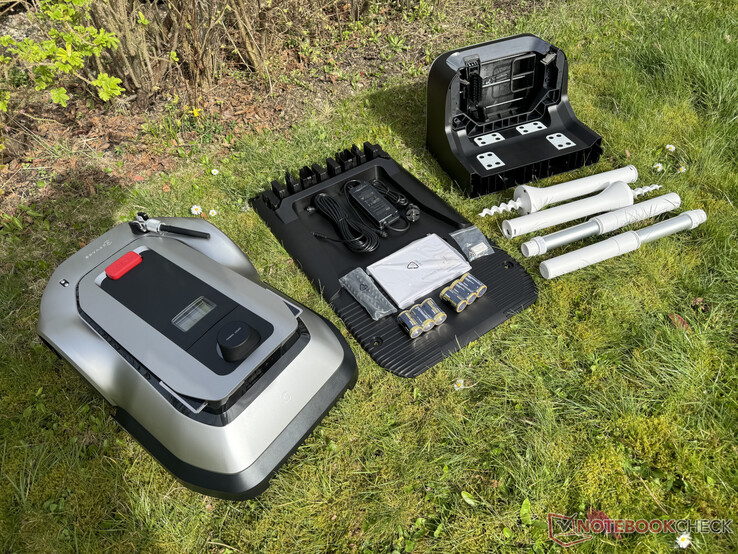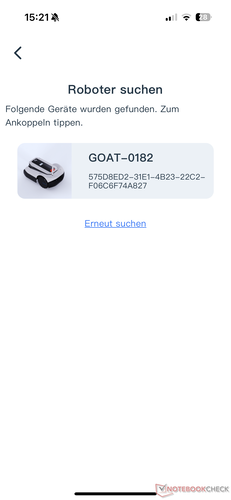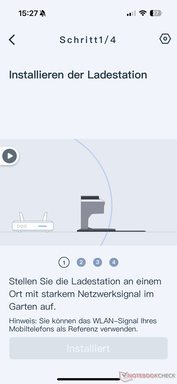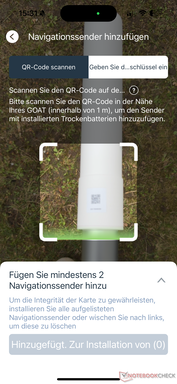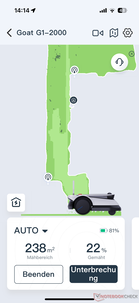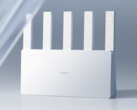Ecovacs Goat G1 (2000/1600/800) hands-on review: Robot lawn mower without boundary cables for gardens of various sizes
Last year, Ecovacs released its very first robotic lawn mower, the Goat G1 (now called Goat G1-1600). The company has continued to expand its lawn mower range this year, launching not only the unique Goat GX-600 (€1,299, or US$1,299) but also two similarly designed Goat G1 models for lawns of various sizes: the Goat G1-800 and G1-2000.
We spent the past few weeks going hands-on with the Goat G1-2000, the current top-tier model for larger gardens. In this hands-on review, you’ll find out what we think about the Ecovacs Goat G1-2000 and what the differences are between the three models.
Overview: Differences between Ecovacs Goat G1-2000, G1-1600 and G1-800
Apart from a few minor differences, the Ecovacs Goat G1-2000, G1-1600 and G1-800 largely share the same design. Specifically, they differ in their battery capacity, which determines the lawn size they are best suited to, with the model number representing the area in square metres. The three models also have distinct colours (although this is less important) as well as a few other slight variations.
The table below provides a quick overview of the similarities and differences between them:
| Specs/Model | Ecovacs Goat G1-800 | Ecovacs Goat G1-1600 | Ecovacs Goat G1-2000 |
|---|---|---|---|
| Area | up to 800 sqm | up to 1,600 sqm | up to 2,000 sqm |
| No. of beacons included | 2 | 2 | 4 |
| Battery | 4 Ah | 5.2 Ah | 8.7 Ah |
| Connectivity | Wi-Fi + Bluetooth | Wi-Fi + Bluetooth (4G optional) | Wi-Fi + Bluetooth + 4G |
| Cutting width | 220 mm | 220 mm | 220 mm |
| Cutting height | 3 - 6 cm | 3 - 6 cm | 3 - 6 cm |
| Colour | Grey/white | White | Silver |
| Garage | optional | optional | included |
| Price (RRP) | €1,099 (US$1,180) | €1,299 (US$1,397) | €1,999 (US$2,149) |
Besides the ones listed above, there are additional differences in the wheels. The ones on the Goat G1-2000 offer an exceptionally high level of grip, making this model ideal for challenging terrain. Additionally, the highest-capacity model comes equipped with 4G by default, ensuring connectivity even without a Wi-Fi network, whereas this feature is optional for the Goat G1-1600. In contrast, the Goat G1-800 requires complete Wi-Fi coverage in your garden if you wish to remotely control the robot lawn mower at any time, as it doesn't support Bluetooth.
Specifications: Overview of features and box contents
Let’s start with what is included in the box with the Goat G1. Besides the robot itself, every variant is shipped with a charging station, which consists of two parts to be assembled, a long charging cable, two beacons, the necessary batteries, several other accessories, and the usual documentation.
For the Goat G1-2000, you’ll also get a second box containing a garage for the robot and two additional beacons with batteries included. The garage keeps the top-end model dry, whilst you may need to purchase or build a separate shelter to protect the more affordable models when they are not in use.
Taking a closer look, we see that the Goat G1 is a robotic lawn mower that operates without boundary cables, a feature that is becoming increasingly common on the market. Instead of having to laboriously lay down a wire around the area to be mowed, you simply need to install a few ultra-wideband (UWB) beacons at strategic places according to the manufacturer’s instructions, which vary depending on the shape of your lawn.
The robot lawn mower utilises the beacons to find its way around the mowing area. The number of beacons included varies with the model, ranging from two to four, and there’s an option to buy additional ones if needed. Ecovacs has also installed two cameras to aid in navigation and obstacle avoidance. In addition to a fisheye camera with a 150° field of view positioned on top, the Goat G1 features a visual sensor and a time-of-flight (ToF) sensor at the front, which are all used for detecting obstacles. We’ll discuss how well this system works later in this review.
All three mower variants boast a cutting width of 22 cm (8.7 in) as well as a cutting height adjustable between 3 and 6 cm (approx. 1.2 and 2.4 in) in 13 steps. The adjustment is manual, employing a mechanical process rather than the electronic one found in the Dreame A1 (retailing €1,999 on Amazon). Consequently, although the cutting height can’t be modified via the app, the system is probably more robust and long-lasting.
Setup: Beacons instead of perimeter wires
Once the robot lawn mower is unboxed, start by setting up the included charging station at an appropriate location. Next, simply connect the power cable and dock the robot in the charging station. The base also features a small clever design element: it cleans both the top and front cameras with a set of brushes that move back and forth.
After downloading the Ecovacs app for Android or iOS and creating an account (if you don’t have one yet), it is necessary to establish a connection between the app and the robot lawn mower. The app provides an effective guide for the user, which is why we are only going to illustrate the process with a few screenshots.
As previously mentioned, Ecovacs has opted to forgo the usual boundary wire system for the Goat G1. Instead, the robot uses beacons to navigate the mowing area. They must be installed at the perimeter of the mowing zone according to the manufacturer’s instructions, which simply involves screwing them into the ground. But before that, you need to insert the three provided D batteries into each beacon and scan a small QR code with the app.
At least two beacons are included in the box. The complexity and shape of your lawn may necessitate the use of up to five beacons. Additional beacons can be purchased separately at an RRP of €99 (US$107) each. The official instruction manual has a guide on where to place the beacons.
The Goat G1’s wireless beacons stand at around 75 cm (29.5 in) tall and are quite noticeable at first glance due to their radiant white colour. This is something to be aware of before you purchase an Ecovacs robot lawn mower. However, based on our experience, after the beacons have been installed in your garden for a few days, you will start noticing them less and get used to them, even though there are certainly more elegant and less perceptible solutions available.
Once basic setup is completed in the app, the lawn mower must learn about its new environment. You have to use a virtual joystick in the app to manually guide the robot once around the lawn’s perimeter. We think this solution is somewhat easier and more intuitive than the dual controllers used for the Navimow i105E/108E, especially considering the Goat G1 also moves at a slower pace. Although this makes the initial learning process slightly more time-consuming, it still takes no more than a few minutes to complete, varying with the garden’s size.
However, unlike its Segway Navimow competitor, the Ecovacs machine lacks AI-based autonomous boundary detection. But you have the option to create “no-entry zones” to keep the Goat G1 away from objects like trees, bushes, pools, trampoline and so on.
After being manually guided around the perimeter, the robot will explore and scan the area again autonomously to familiarise itself with the lawn. It usually takes just a few minutes for the Ecovacs Goat G1 to be ready for use.
Overall, the setup process went well during our testing. There were only a handful of problems when we tried setting it up again on a new test area. Simply deleting the old map wasn’t enough. We only managed to get it working after completely removing the lawn mower’s entry in the app and rescanning the beacons. That said, this is a minor issue that isn’t very relevant to most users.
Mowing: Intelligent navigation and obstacle detection
Using the beacons and the generated map, the robot traverse the lawn in a mostly systematic fashion. It was sometimes difficult to comprehend the order in which the sections are mowed, but overall there isn’t much to complain about. The Goat G1 methodically mows the lawn row by row, which is naturally much more efficient than the random pattern of older robot lawn mowers that rely on boundary wires and results in an aesthetically pleasing mowing pattern. In the app, you can adjust the width of each row to one of the two settings: fine or efficient. The grass turned out very uniform in our testing.
By request, the robot can also trim the entire perimeter of the lawn. As you might be aware, the Ecovacs Goat G1 doesn’t operate with boundary wires to demarcate the edges. Consequently, it has to independently navigate the edges using only the beacons and its obstacle detection as a guide. The robot occasionally left a pretty large gap at the edges, leading to some uncut grass.
For one, this is due to the blade disc's central placement, approx. 10 cm (3.9 in) from the device’s edge. Additionally, the robot didn’t quite follow the boundary exactly as we had instructed during the mapping process. Sometimes, it may perceive a plant in an adjacent bed as an obstacle and decide to make a larger turn around it.
In summary, as with a traditional lawn mower, it is necessary to manually trim lawn edges after using the Ecovacs Goat G1 if your garden isn’t perfectly designed for robotic mowing with flat transitions and broad edges.
The Goat G1 encountered a few minor challenges in tight spaces. Ecovacs says that the mowing area must be at least 1.5 m (4.9 ft) wide. However, the G1 struggled to consistently reach a small part of our test area that is nearly 2 m (6.6 ft) wide, yet it marked this section as trimmed after the mowing process. All things considered, the robot still did a commendable job and mowed the designated area reliably.
During our review, the obstacle detection on the Ecovacs Goat G1 (800/1600/2000) functioned almost flawlessly. The robot lawn mower consistently recognised a realistic hedgehog figurine from every angle in multiple tests. It also managed to reliably detect and avoid a plush hedgehog (which previously caused issues for the Navimow i105E) as well as balls of various sizes, a football goal, a swing frame, garden tools and people.
The Goat G1 generally detected obstacles very early and maintained a considerable distance to avoid them. Whilst this leaves a bit more untrimmed area than necessary, it is definitely safer. The only thing that pushed the robot to its limit was a pair of garden scissors, which was lying on the ground and thus barely stuck out. Obstacles need to be around 10 cm (3.9 in) high in order for the lawn mower to detect them effectively, though this sensitivity may vary depending on the settings in the app.
The robot automatically returned to the charging station when it began to rain, a feature that mostly proved to be reliable and fast during our testing. There was only one instance where the Goat G1 mistakenly attempted to dock in an adjacent charging station that belonged to the Dreame A1, which was being tested in parallel.
Battery and noise level: Ecovacs Goat G1-2000 lasts three hours on a single charge
In our testing, the Goat G1-2000 lasted roughly three hours before returning to the charging station with 15% left in its battery. Our measurements indicated that a full charge took about 3.5 hours, though the battery was already back at 80% after close to 1.5 hours. The robot lawn mower automatically resumed its task once it attain this level of charge.
The product managed to cover roughly 300 sqm (3,229 sqft) on a single charge in our test. It's important to note that the coverage can vary based on the specific site conditions and the settings used. If the robot operates for twelve hours straight in summer, including two approximately 90-minute charging breaks, its daily coverage will be around 900 sqm (9,688 sqft). This suggests it should be able handle the 2,000 sqm (21,528 sqft) target in two days.
Around 135 Wh of power flowed into the battery whilst it was being charged from 15 to 80%. Getting the battery from 15 to 100% required approx. 165 Wh. The charging speed was around 115 W, and the standby power usage was close to 4.5 W.
If the Goat G1-2000 operates twelve hours per day, its daily power consumption will be approx. 500 Wh. Extrapolating this data yields a monthly power usage of about 15 kWh. Assuming electricity costs €0.35 (US$0.38) per kWh, you can expect a monthly electricity bill of slightly more than €5 (US$5.4). Of course, this figure will decrease accordingly if the lawn is smaller or doesn’t have to be mowed every day.
The two lower-capacity models, Ecovacs Goat G1-800 and G1-1600, can’t operate for as long between charges. These two models have smaller batteries since they are designed to handle 800 and 1,600 sqm (8,611 and 17,222 sqft) respectively.
Measured from 1 m (3.3 ft) away, the Goat G1-2000 emitted approx. 60 dB of noise during operation. The noise level is highly dependent on the height and thickness of the grass, and thus the mowing task at hand. However, the review unit doesn’t get much quieter when it’s just moving and is considerably louder than, for example, the Navimow i105E.
App: The robot lawn mower is also a surveillance camera
As you may already know from their robot vacuums, the Ecovacs app for Android and iOS for the Goat G1 feels quite polished as well – and it’s not just the setup process that impresses. The start page of every registered device delivers real-time info about its current status at first glance. When the robot lawn mower is running, the completed area will be colour-coded on the virtual map and indicated in square metres and percentage. This feature helps you constantly keep track of the progress. The same applies to the battery level, whether the mower is in operation or charging.
There is also an overview of activities and numerous settings, including mowing efficiency and mowing direction. In the settings, you can also enable the rain sensor and animal protection feature, and customise the obstacle avoidance mode based on the environment (e.g. flat ground with short grass, general environment, uneven ground with tall grass). This is meant to prevent the robot erroneously detecting taller grass as an obstacle and leaving it untrimmed. The settings also offer other safety and theft-protection functions.
One nice gimmick is that the app gives you real-time access to the cameras on the Ecovacs Goat G1, allowing you to turn the robot into some sort of roaming security camera. In our testing, the video quality wasn’t particularly high, but it also depends on signal transmission. Two-way communication is possible as well.
Pros
+ easy to set up without boundary cables
+ systematic mowing
+ various models available for lawn sizes up to 800, 1600 or 2000 sqm
+ effective obstacle detection
+ feature-rich and polished app
+ 4G (optional in some models) and theft protection
Cons
– fairly wide untrimmed edges if transitions aren't level
– beacons interfere with a garden's aesthetic
Verdict: Almost a downright compelling robot lawn mower without boundary cables
The Ecovacs Goat G1-2000 had a great showing in our review. Whilst the mandatory beacons definitely aren’t the perfect solution as garden “ornaments”, seeing that other manufacturers offer more elegant takes on this technology. Nevertheless, they are definitely an acceptable alternative compared with the traditional perimeter wires, which are more cumbersome and susceptible, especially because the beacons are quick and easy to set up.
In terms of navigation and obstacle detection, the Ecovacs Goat G1-2000 largely demonstrated good reliability and performance. However, like most robot lawn mowers, it falls short in edge trimming performance, particularly around plant beds or uneven edges.
We were also impressed by the app, even though it exhibited “quirks” on a few occasions. Overall, the Ecovacs Goat G1 left a positive impression in our testing.
Price and availability of the Ecovacs Goat G1 series
Thanks to the recent expansion of the Goat G1 series, there are now three models tailored to gardens of sizes up to 2,000 sqm (21,528 sqft).
The Ecovacs Goat G1-2000 featured in this review is the top-tier model in the series. It is capable of handling up to 2,000 sqm (21,528 sqft) and has a recommended retail price of €1,999 (US$2,155), with a garage included. The lower-capacity Goat G1-1600 and G1-800 have an RRP of €1,299 (US$1,400) and €1,099 (US$1,185) respectively.
Transparency
The present review sample was made available to the author as a loan by the manufacturer or a shop for the purposes of review. The lender had no influence on this review, nor did the manufacturer receive a copy of this review before publication. There was no obligation to publish this review.


 Deutsch
Deutsch English
English Español
Español Français
Français Italiano
Italiano Nederlands
Nederlands Polski
Polski Português
Português Русский
Русский Türkçe
Türkçe Svenska
Svenska Chinese
Chinese Magyar
Magyar

